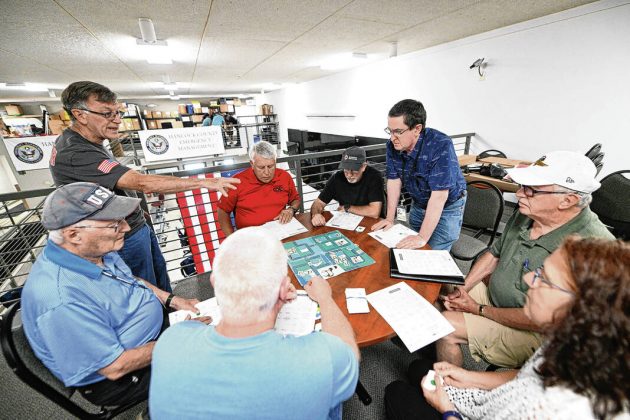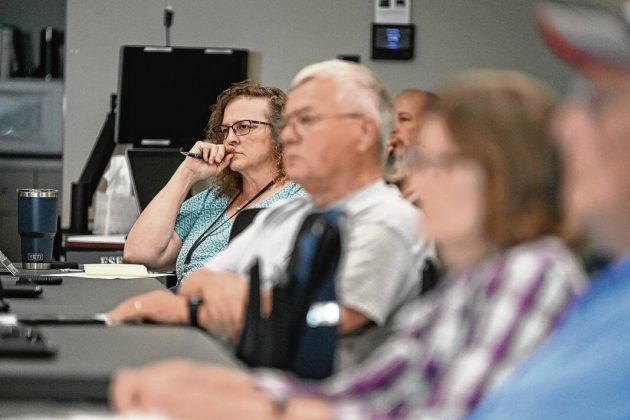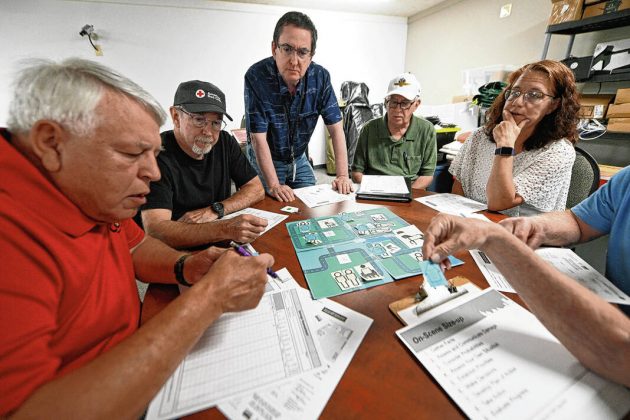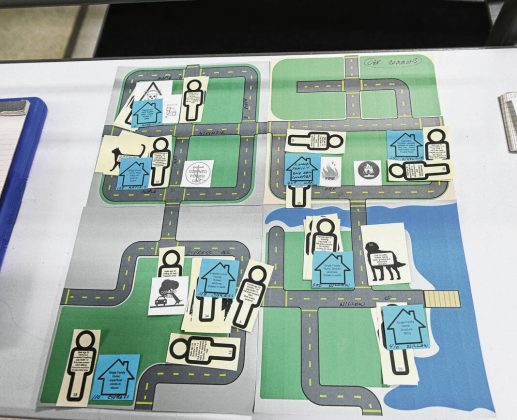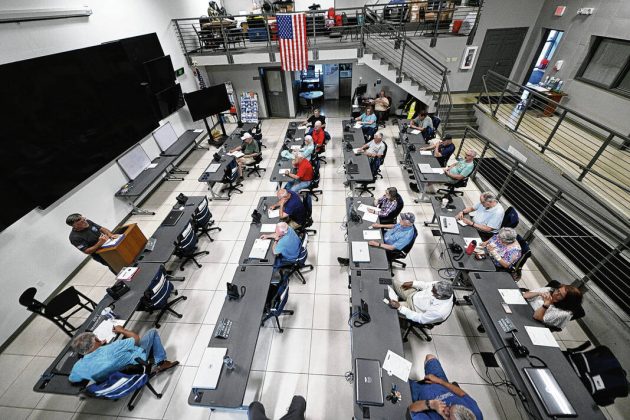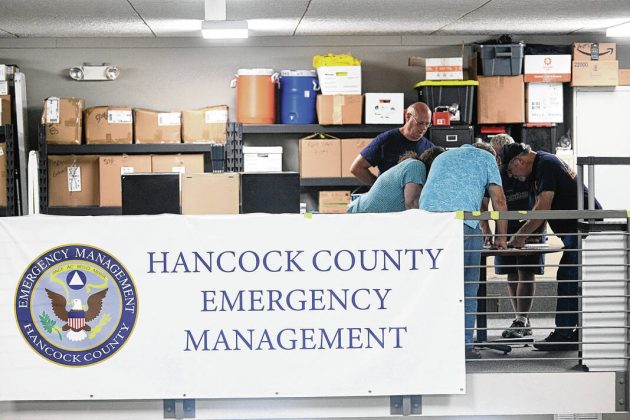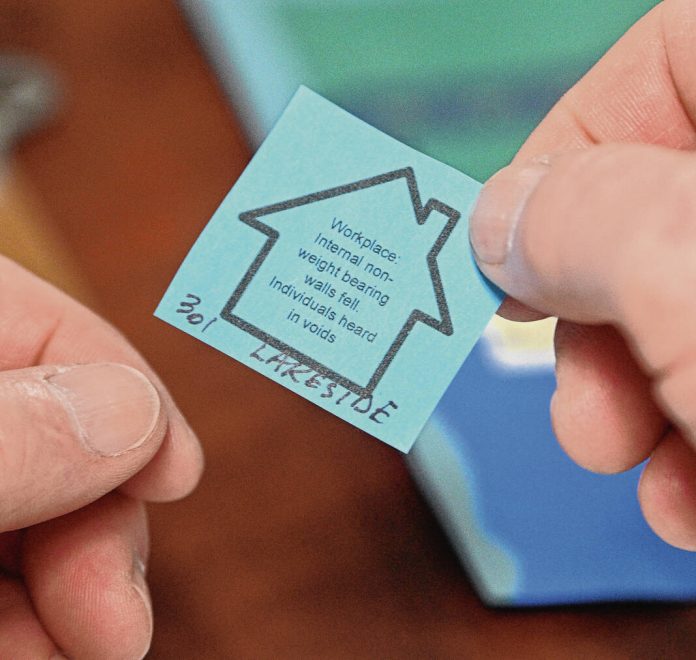
An example of one of the issue volunteers may face in a real emergency. A Disasterville tabletop exercise to simulate a Neighborhood Rapid Disaster Assessment was held last week in Greenfield at the Emergency Management Center.
GREENFIELD — Disasterville, a tabletop activity that simulates neighborhood rapid disaster assessments, was held last week at the Emergency Management Center in Greenfield.
Volunteers from organizations such as the Red Cross and Salvation Army came together with members from the Community Organizations Active in Disaster, COAD, to practice the steps needed in order to quickly and effectively access surrounding neighborhoods in case of a future natural disaster.
One volunteer was very pleased with how the community came together to practice these situations. Dennis “Danny” Smith is the assistant state director of Southern Baptist Disaster Relief and has been working with the organization for 25 years. He was one of the volunteers that helped aid Sullivan after the tornado damage in early April.
“By being in the real thing and then through this, I think it was good information,” Smith said. “It’s gonna be a lot different in reality, I guarantee that. They need to do this more often and kind of get it to the point where they get it down pat.”
Smith later said the tabletop activity puts Hancock County on the right track to being very well prepared, and that he sees some counties that have not yet.
The tabletop exercise simulated three neighborhoods throughout Greenfield, those being Oak Commons, Waterview and Sherwood. In those neighborhoods, scenarios went into details such as infrastructure damages, victims’ conditions and animal conditions. Each volunteer was assigned a role and a neighborhood.
Jim Peters, board chair of Hancock County COAD, has been a part of the organization since it started in 2013, and was the one who set up the simulated neighborhoods.
“It’s intended to be a test of how we will respond immediately within our own neighborhoods, and the folks around us,” Peters said.
From there, volunteers had to go through the assigned neighborhood and follow what was called a “one-scene size-up” list which included; gathering facts, accessing and communicating the damages, considering possibilities and establishing what takes priority, then making decisions and taking action.
With those guidelines, volunteers went through each street, made notes of victims’ conditions and infrastructure damage, and determined whether they were life threatening or not. After one neighborhood was assessed, the volunteers reached out for first responders for victims in critical conditions. In the simulation, first responders were 30 minutes away from the scene.
Peters said that these types of activities are important to practice because during real life events, professionals and first responders will be pulled in every direction and may not be available to address every situation, causing delays in response time.
Dwayne Caldwell, volunteer with the Emergency Management Agency, has been working with the EMA since 1991. He said one of his main takeaways from attending these events is the relationships that he forms.
“Emergency response runs on relationships,” Caldwell said. “At midnight next to a gas leak in a hail storm is not a time to start making friends. I need to know these people beforehand to be able to work with them.”
Caldwell said it allows more opportunity for new faces and different perspectives to be added to each meeting, creating a chance for new questions. The different backgrounds between each of the volunteers allows for more insight.
Joe Fitzgerald, deputy director of Emergency Management, worked alongside Caldwell that night and touched on the point. Fitzgerald mentioned how they have doctors, pharmacists, engineers, electricians and others that volunteer, creating a huge gap in the information with their organizations.
Fitzgerald is also a retired firefighter, worked 20 years at the sheriff’s department as a reserve and has been working at the EMC for seven years, bringing his own knowledge of how to deal with natural disasters and emergencies.
“Emergencies never go as planned… The more you practice and the more different scenarios you do, the better ability you have to adapt in a real situation,” Fitzgerald said.
Another tip Fitzgerald said is good to know during emergency situations is the 72-hour rule. This means someone needs supplies to take care of themselves for three days after a natural disaster happens in case first responders are delayed. Supplies should include water, food and medicine for medical needs.
After the simulation ended, Peters and volunteers gathered back to discuss how the process went and any general observations or comments. A few volunteers spoke up.
Chaos.
Peters said he intentionally made the simulation neighborhoods with many scenarios, because in reality that’s how the results of a natural disaster can be, and also knowing people will be less calm when it’s their neighborhoods.
A good way to approach these situations according to Peters is to divide and conquer. This could be having pairs of people splitting up and taking a couple streets in a neighborhood to speed up the process.
A final point that strikes Peters every time they do simulations like Disasterville is knowing who you live next to.
“We really need to do a better job of knowing who our neighbors are,” Peters said. “Chances are in each of those neighborhoods there are some skilled medical professionals… if those of you that are out and about trying to get something done, you know where they live.”
Trainings are held the first Thursday of each month, and are open to the public. Gun safety and self defense will be held in July and narcan training in August.

